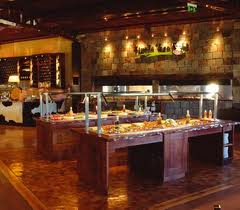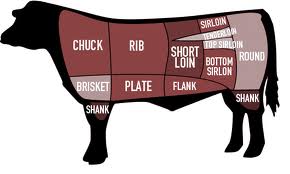For those of you who are familiar with Argentina, you know that when it comes to meat the portions almost never leave you asking for more. Eating meat, and lots of it, comes easily to us and so the idea of an all you can eat meat buffet is nothing too terribly out of the ordinary for us. It’s like any regular old Sunday.
Siga la Vaca came into existence about 20 years ago when a group of entrepreneurs associated with the beef industry decided to try something a little different. They opened their first space about 40 kilometers off PanAmerican Highway and it has space to accommodate up to 50 people. The idea was that at a fixed price their customers could come in sit down and eat until their bellies burst or they had to be rolled out. Since 1993 their first location has grown to hold as many as 300 people. In 1996 they opened another location in San Isidro with enough room for 350 people. Their popularity grew leaps and bounds when they finally made it to the beautiful area of Puerto Madero. This is their biggest location yet seating 450 people.
Up until recently I never really had much interest but for the sake of the beef I decided to give it a try. I made my way down to Puerto Madero and was greeted by their signature friendly looking cows at the door (don’t worry, they’re not real). When I arrived the place was relatively crowded but due to the fact that they have over 450 seats I didn’t wait for more than a minute to be seated. The waitstaff was extremely friendly and helpful when it came to explaining all about how everything was supposed to work. They brought me my included wine (yes, you do get wine or beer included) and I was to the salad bar.
There was actually a large selection of fixings at the salad bar including things like pickled vegetables and already made bean salads etc. While it wasn’t the best salad I’ve ever had I have no qualms with it, in fact, I went back for seconds. I took ‘all you can eat’ to be a challenge you see. The other nice thing about the salad bar is its close proximity to what I’d refer to as the ‘meat bar’. You can scope it out a bit and get a feel for what’s on the parrilla. The moment had come, time for the star of the show. Siga la Vaca has an impressive selection of meats of all different type: pork, chicken, beef. Luckily for me I have a good idea of what everything looks like on the parrilla but I could see how someone who had little to no knowledge of Argentine beef it would be practically impossible to navigate, big flaw. People typically like to know what it is you’re getting into. The idea is that you just walk up, find something you like and point.
While the idea of Siga la Vaca is a good one the actual execution is a bit lackluster. Everything that I tried was a bit overcooked or not quite right. It wasn’t bad but it just wasn’t great. This isn’t surprising to me considering the fact that the parrillas are going all day just waiting for the next person to come pick their food. There’s no real way to avoid overcooking or drying out while you’re trying to keep everything prepared and warm, especially if it’s for 450 some people. The buffet style is very American in feel and not something that I would consider authentic. Unfortunately it’s not a place that I would ever go back to but considering what you pay it can be an interesting experience for a curious individual.















 The difference between vacio and cuts like ojo de bife (a derivative of the rib-eye) lies with the distribution of the fat. Ojo de bife contains what we call marbling which is internal lines of fat that dissolve and add flavor to the meat when cooked. Vacio simply has an entire layer of fat along one side of the enormous cut. I say enormous because the flank steak is placed on the grill in its entirety. In my case, I watched the porteno (Buenos Aires resident) who was teaching me the way of the asado cook a 3 kilogram slab of vacio all at once.
The difference between vacio and cuts like ojo de bife (a derivative of the rib-eye) lies with the distribution of the fat. Ojo de bife contains what we call marbling which is internal lines of fat that dissolve and add flavor to the meat when cooked. Vacio simply has an entire layer of fat along one side of the enormous cut. I say enormous because the flank steak is placed on the grill in its entirety. In my case, I watched the porteno (Buenos Aires resident) who was teaching me the way of the asado cook a 3 kilogram slab of vacio all at once.





